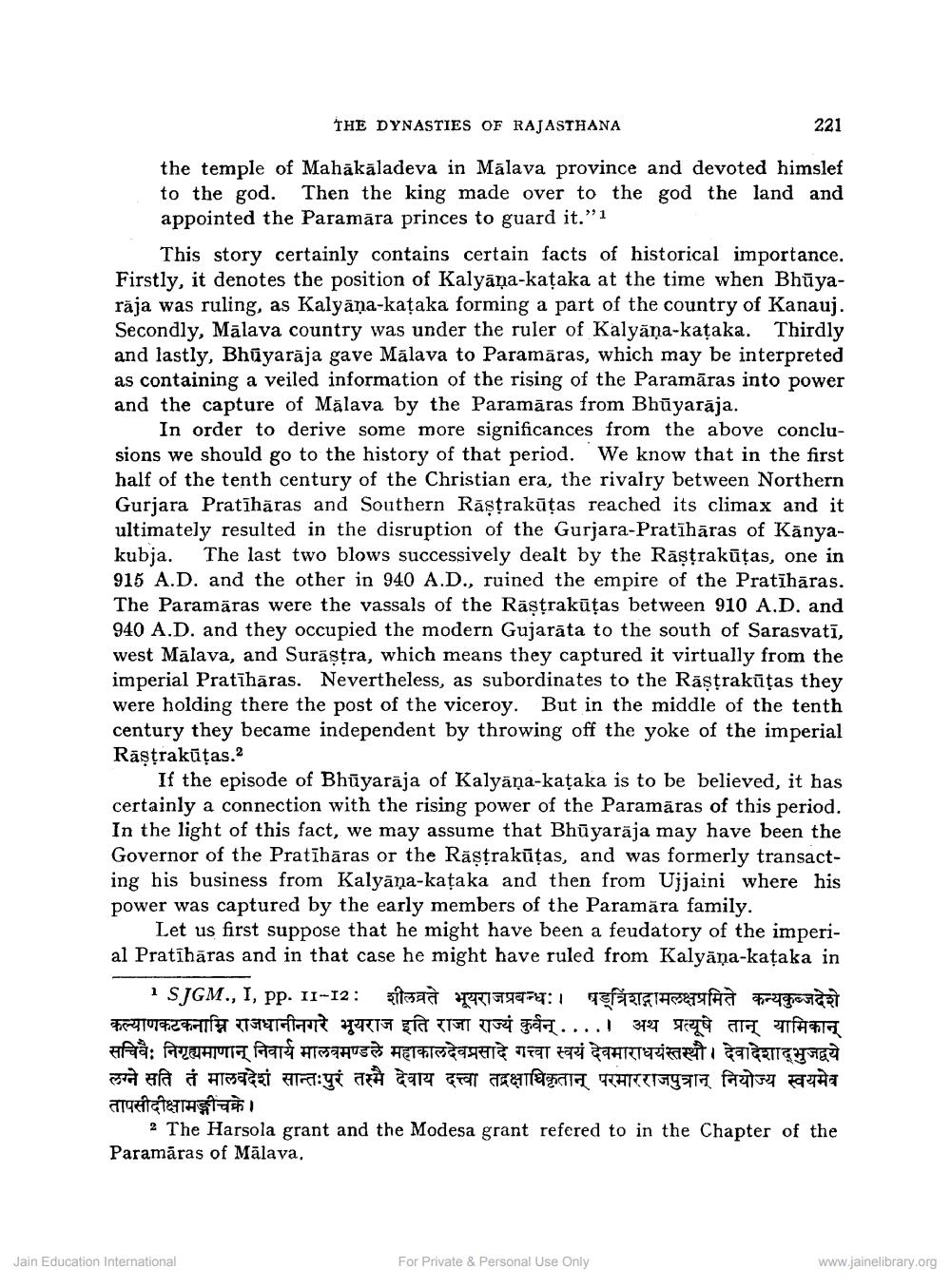________________
THE DYNASTIES OF RAJASTHANA
221
the temple of Mahākāladeva in Mālava province and devoted himslef to the god. Then the king made over to the god the land and appointed the Paramāra princes to guard it."1
This story certainly contains certain facts of historical importance. Firstly, it denotes the position of Kalyāņa-kataka at the time when Bhūyarăja was ruling, as Kalyāņa-kațaka forming a part of the country of Kanauj. Secondly, Mālava country was under the ruler of Kalyāņa-kataka. Thirdly and lastly, Bhūyarāja gave Mālava to Paramāras, which may be interpreted as containing a veiled information of the rising of the Paramāras into power and the capture of Mālava by the Paramāras from Bhūyarāja.
In order to derive some more significances from the above conclusions we should go to the history of that period. We know that in the first half of the tenth century of the Christian era, the rivalry between Northern Gurjara Pratīhāras and Southern Răstrakūtas reached its climax and it ultimately resulted in the disruption of the Gurjara-Pratīhāras of Kanyakubja. The last two blows successively dealt by the Răstrakūtas, one in 915 A.D. and the other in 940 A.D., ruined the empire of the Pratīhāras. The Paramāras were the vassals of the Rastrakūtas between 910 A.D. and 940 A.D. and they occupied the modern Gujarāta to the south of Sarasvatī, west Mālava, and Surāstra, which means they captured it virtually from the imperial Pratīhāras. Nevertheless, as subordinates to the Rāșțrakūtas they were holding there the post of the viceroy. But in the middle of the tenth century they became independent by throwing off the yoke of the imperial Rāştrakūtas.
If the episode of Bhūyaraja of Kalyäņa-kataka is to be believed, it has certainly a connection with the rising power of the Paramāras of this period. In the light of this fact, we may assume that Bhūyarāja may have been the Governor of the Pratīhāras or the Răstrakūtas, and was formerly transacting his business from Kalyāņa-kataka and then from Ujjaini where his power was captured by the early members of the Paramāra family.
Let us first suppose that he might have been a feudatory of the imperial Pratīhāras and in that case he might have ruled from Kalyāņa-kataka in
I SJGM., I, pp. 11-12: itsad 15972: Efeigiama para कल्याणकटकनाम्नि राजधानीनगरे भुयराज इति राजा राज्यं कुर्वन् ....। अथ प्रत्यूषे तान् यामिकान् सचिवैः निगृह्यमाणान् निवार्य मालवमण्डले महाकालदेवप्रसादे गत्वा स्वयं देवमाराधयंस्तस्थौ। देवादेशाभुजद्वये लग्ने सति तं मालवदेशं सान्तःपुरं तस्मै देवाय दत्त्वा तद्रक्षाधिकृतान् परमारराजपुत्रान् नियोज्य स्वयमेव तापसीदीक्षामनीचके।
2 The Harsola grant and the Modesa grant refered to in the Chapter of the Paramāras of Mālava.
Jain Education International
For Private & Personal Use Only
www.jainelibrary.org




